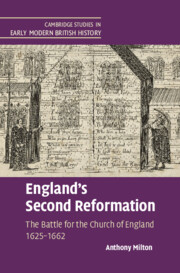Book contents
- England’s Second Reformation
- Cambridge Studies in Early Modern British History
- England’s Second Reformation
- Copyright page
- Dedication
- Contents
- Acknowledgements
- Abbreviations
- Introduction
- Chapter 1 An Unresolved Reformation
- Chapter 2 Situating the Laudian Reformation
- Chapter 3 Responses to the Laudian Reformation
- Chapter 4 The Abortive Reformation, 1640–1642
- Chapter 5 The End of Episcopalian Reformation
- Chapter 6 Reformation by Negotiation
- Chapter 7 The Westminster Reformation and the Parliamentarian Church of England
- Chapter 8 The Royalist Church of England, 1642–1649
- Chapter 9 Alternative Reformations, 1649–1653
- Chapter 10 The Cromwellian Church
- Chapter 11 Episcopalian Royalism in the 1650s
- Chapter 12 Failed Reformations, 1659–1661
- Chapter 13 The End of Comprehensive Reformation and the Caroline Settlement
- Conclusion
- Index
Chapter 9 - Alternative Reformations, 1649–1653
Published online by Cambridge University Press: 05 October 2021
- England’s Second Reformation
- Cambridge Studies in Early Modern British History
- England’s Second Reformation
- Copyright page
- Dedication
- Contents
- Acknowledgements
- Abbreviations
- Introduction
- Chapter 1 An Unresolved Reformation
- Chapter 2 Situating the Laudian Reformation
- Chapter 3 Responses to the Laudian Reformation
- Chapter 4 The Abortive Reformation, 1640–1642
- Chapter 5 The End of Episcopalian Reformation
- Chapter 6 Reformation by Negotiation
- Chapter 7 The Westminster Reformation and the Parliamentarian Church of England
- Chapter 8 The Royalist Church of England, 1642–1649
- Chapter 9 Alternative Reformations, 1649–1653
- Chapter 10 The Cromwellian Church
- Chapter 11 Episcopalian Royalism in the 1650s
- Chapter 12 Failed Reformations, 1659–1661
- Chapter 13 The End of Comprehensive Reformation and the Caroline Settlement
- Conclusion
- Index
Summary
Chapter 9 explores the period 1649-53 as a time when all religious groups were forced to rethink the Church of England and to contemplate significant changes to their religious lives. Beginning with the radical reform programmes of 1649-53, it argues that many of these reforms (such as attacks on lay impropriations and tithes) had been prefigured in pre-war debates or could command more mainstream support, and can be studied in continuity with earlier reforming initiatives rather than as a radical break with the past. The stymieing of the 1640s Presbyterian settlement, and the political troubles of presbyterian royalists, are examined. The chapter discusses the practical and ideological problems that both Presbyterians and episcopalian royalists faced over how far they should adapt their customary forms of worship and administration of communion in the face of the new settlement, and documents their failure to create agreed positions on conformity. The chapter also outlines the negotiations conducted by Charles II and his ministers with the Scottish Covenanters, delineating not a simple capitulation but a series of negotiations involving foreign divines, where forms of reduced episcopacy were still being discussed, but ending with an alliance which drove episcopalian royalists to question the royal supremacy.
Keywords
- Type
- Chapter
- Information
- England's Second ReformationThe Battle for the Church of England 1625–1662, pp. 293 - 334Publisher: Cambridge University PressPrint publication year: 2021

